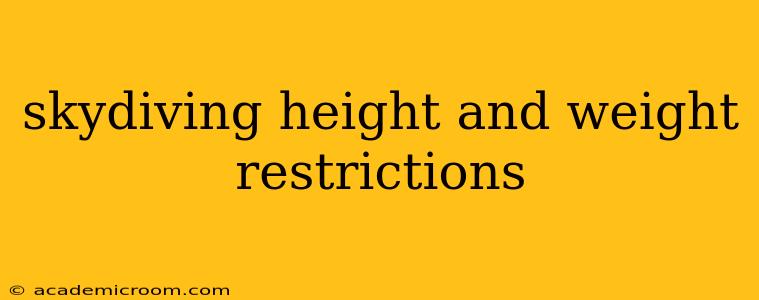Skydiving is an exhilarating adventure, but safety is paramount. Before you take the leap, understanding the height and weight restrictions is crucial. These limitations aren't arbitrary; they're based on safety protocols and the physics of freefall. This comprehensive guide will delve into the specifics, addressing common questions and concerns.
What is the minimum height requirement for skydiving?
There isn't a universal minimum height requirement for skydiving. Drop zones primarily focus on weight and age restrictions. However, some drop zones may have minimum age requirements, typically around 18 years old, sometimes even higher depending on the specific location and the type of jump. The critical factor is whether you're tall enough to safely and comfortably fit the parachute harness. If you are significantly shorter than average, it's essential to contact the drop zone directly to discuss your suitability.
What is the maximum weight limit for skydiving?
This is where the specifics become more defined. The maximum weight limit for skydiving varies considerably between drop zones and often depends on the type of aircraft used and the parachute systems available. Generally, the maximum weight limit ranges from 220 to 250 pounds (100 to 113 kg), though some operators may have higher limits with specific equipment or tandem arrangements. Exceeding the weight limit poses significant safety risks, as heavier individuals require larger parachutes and more powerful equipment to ensure a safe landing.
What are the tandem skydiving weight restrictions?
Tandem skydiving, where you jump with an experienced instructor, typically has stricter weight restrictions than solo jumps. This is because the instructor carries additional weight and equipment. Weight limits for tandem jumps usually fall between 220 and 240 pounds (100 to 109 kg). Again, it is vital to contact the specific drop zone for their precise policy.
Can overweight people skydive?
While many drop zones have weight limits, it doesn't automatically exclude all individuals exceeding those limits. Some drop zones may have specialized equipment or accommodations for heavier individuals, but this often requires prior arrangement and may involve additional costs. Contacting the drop zone directly to discuss your specific circumstances is essential. Remember, safety is the top priority.
How does height affect skydiving?
Height itself doesn't directly restrict skydiving. However, being significantly shorter than average might impact harness fitting. As mentioned earlier, it's crucial to contact the drop zone and discuss this to ensure a proper and safe harness fit.
Are there age restrictions for skydiving?
Yes, most drop zones have a minimum age requirement, typically 18 years old. Some drop zones may even have upper age limits depending on physical fitness assessments. Always check the specific requirements of the drop zone you plan to visit.
What happens if I exceed the weight limit?
If you exceed the weight limit at a specific drop zone, you will likely be unable to skydive there. They may suggest alternative activities or recommend drop zones with potentially higher weight limits. Don't be discouraged – exploring your options is key.
Disclaimer: This information is for general guidance only. Always contact the specific skydiving center directly to confirm their current height, weight, and age restrictions before booking a jump. Safety is the highest priority in skydiving, and following the specific regulations of each drop zone is essential.
